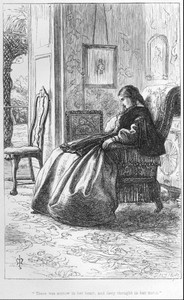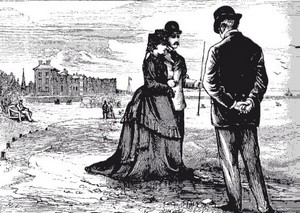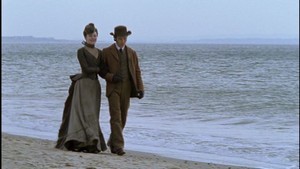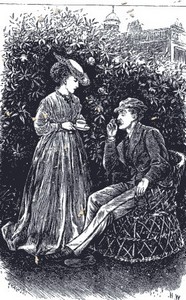Proposal for a paper to be given at NVSA, Spring 2011: Victorian Clichés and Orthodoxies, Columbia University on April 13-15, 2012
“'Where did it come from?': how illustrations in Trollope's novels tell stories not in the texts"

In an early part of this story I have endeavoured to describe how this woman sat alone, with deep sorrow in her heart and deep thought on her mind, when she first learned what terrible things were coming on her. The idea, however, which the reader will have conceived of her as she sat there will have come to him from the skill of the artist, and not from the words of the writer. If that drawing is now near him, let him go back to it. Lady Mason was again sitting in the same room -- that pleasant room, looking out through the verandah on to the sloping lawn, and in the same chair; one hand again rested open on the arm of the chair, while the other supported her face as she leaned upon her elbow; and the sorrow was still in her heart and the deep thought in her mind. But the lines of her face were altered, and the spirit expressed by it was changed. There was less of beauty, less of charm, less of softness; but in spite of all that she had gone through there was more of strength, -- more of the power to resist all that this world could do to her. Orley Farm (ii, p. 230)
In a recent essay, David Skilton suggests the most fruitful examinations of book illustrations regard these as “collaborators in total meaning production” and study the pictures' many extra-diegetic elements (312-13). He cites as exemplary, scholarly essays which analyze the various close relationships among a novel's words, plot-design, characters and themes; and those that look as well at the vignettes and decorated capitals, variously-sized and sequences of images, and where these are placed (312-13). This kind of work builds on previous studies of art where pre-conceived or assumed (understood) meanings are shown to be typical of or individually emerge from schools of styles. A reader or viewer then reads according to expectations set up, and their own memories of the given novelist's other novels (especially when it's a case of recurring characters) and/or the illustrator's other work.
Using a composite of these approachs, I propose to study the original and recent illustrations to Trollope's novels as contrapuntal pictorial narratives, which align themselves with his novel's dependent or secondary stories, with back or hidden and secret stories (events that occurred in the past which characters remember but are not dramatized); and which elaborate merely hinted-at or adumbrated stories featuring minor characters. My argument will be these tell different stories that provide a countervailing pattern or set of experiences that are at variance with the novel's explicit and dominant values, and that those which subvert the norms of behavior cherished by the apparently interpellated audience use strongly clichéd or sentimental and emotional motifs . For example, in The Vicar of Bullhampton Henry Woods's vignette of Carry Brattle, the novel's “fallen woman” shows her in deep frank distress fleeing the court, in a thicket of grasses, reaching out towards a window in a openly vulnerable way not dramatized in the novel (297), and in Rod Waters's 20th century illustrations for Trollope's Castle Richmond several (facing 82, 185, 361) use stereotypical ragged clothes, hovels, and gothic imagery to visualize and reinforce the gaunt horror of the female famine victims' bodies felt as repulsive by the Trollope's male narrator (Kelleher 250-58). I plan to make a case athat Victorians investigate the sexual pathologies of family life, and the male hegemonic order dependent on primogeniture in implicit pictorial ways.
I will focus on lesser-known illustrations of Trollope's early and mid-career novels (He Knew He Was Right as illustrated by Marcus Stone; The Last Chronicle of Barset as illustrated by George Houseman Thomas) and later and late ones (the above for The Vicar of Bullhampton; The Way We Live Now illustrated by Lionel Fawkes) to show Trollope's involvement with illustration of his texts across his career, and to prove that the inventive insight claimed for John Everett Millais's work on six further novels is found in these, and by extension, other fine illustrators in the era. I will also bring in more recent illustrations to show that these function similarly. These specific illustrations have also been chosen to enable the paper to encompass the direct influence of Victorian textual illustrations on modern filmic visual shots: for example, Anna Massey and Caroline Martin as Aunt and Dorothy Stanbury in the 2004 BBC He Knew He Was Right re-enact Stone's illustrations and repeat variants of Trollope's characters' utterances.
Not just Trollope's titles, but his characters' utterances resonate in readers' minds, are remembered, quoted and re-coined today. A key question asked by the depressed perplexed Josiah Crawley of himself is “Where did it [a check for twenty pounds sterling that he cashed) come from?” (“Where did it come from?” and “How did he get it” are two of The Last Chronicle's obsessive chapter titles.) From my paper listeners can learn where extra-diegetic storytelling in the illustrations of Trollope come from, how they influence modern films, and how such dramatic pictures undermine orthodoxies about the Victorian period which seem still to appeal to a larger public today.
Ellen Moody
George Mason University


Works Cited
Kelleher, Margaret. Trollope's “Castle Richmond, Famine and “Horrid” Novel?” Irish University Review 25:2 (1995):242-62.
Skilton, David. “The Relation between Illustration and Text in the Victorian Novel: A New Perspective.” Word and Visual Imagination: Studies in the Interaction of English Literature and the Visual Arts. Edd. Karl Josef Holtgen, Peter M. Daly, and Wolfgang Lottes. Erlangen: Universitatsbibliothek, 1988. 303-25.
Trollope, Anthony. Castle Richmond, introd. Max Hastings. Illustrations by Rod Waters. London: The Folio Society, 1994.
-------------------------. The Vicar of Bullhampton. London: Bradbury, Evans, 1870. This edition contains all the original illustrations (including vignettes) by Henry Woods.

Home
Contact Ellen Moody.
Pagemaster: Jim Moody.
Page Last Updateember 2011